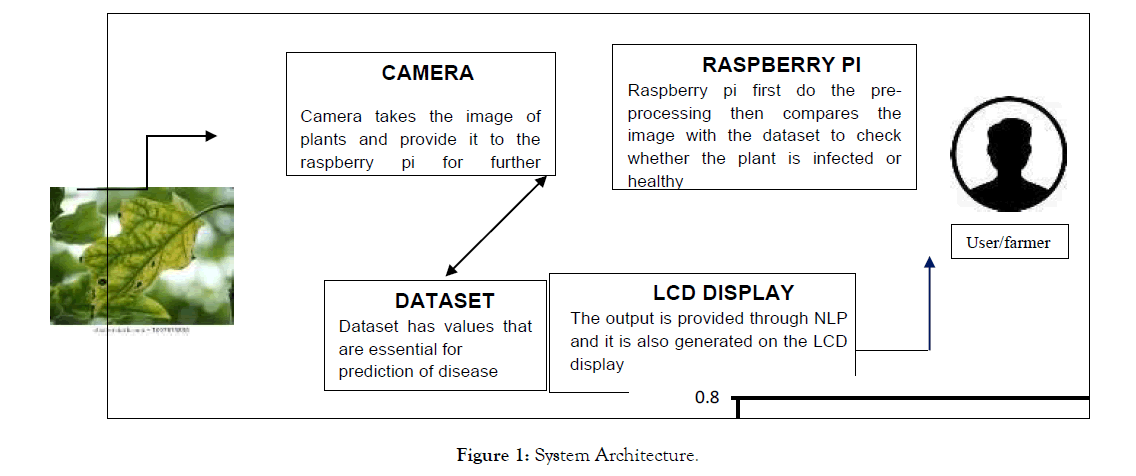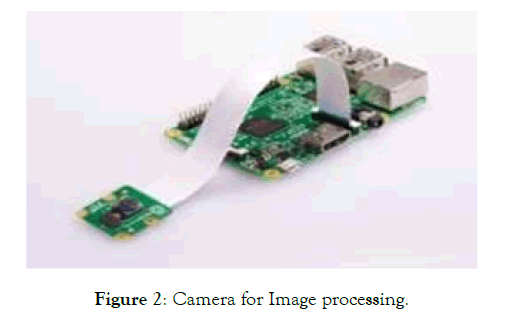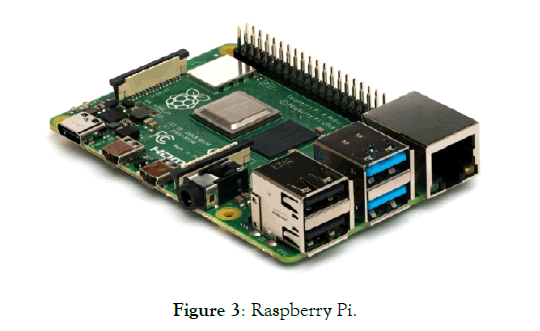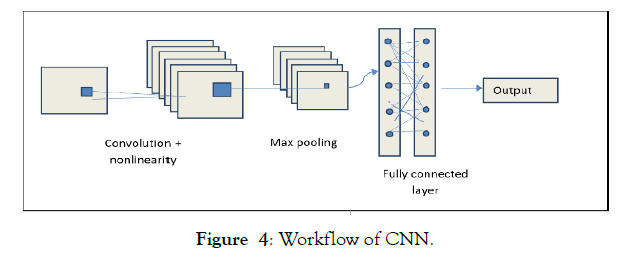Indexed In
- Open J Gate
- Genamics JournalSeek
- Academic Keys
- ResearchBible
- Cosmos IF
- Access to Global Online Research in Agriculture (AGORA)
- Electronic Journals Library
- RefSeek
- Directory of Research Journal Indexing (DRJI)
- Hamdard University
- EBSCO A-Z
- OCLC- WorldCat
- Scholarsteer
- SWB online catalog
- Virtual Library of Biology (vifabio)
- Publons
- Geneva Foundation for Medical Education and Research
- Euro Pub
- Google Scholar
Useful Links
Share This Page
Journal Flyer

Open Access Journals
- Agri and Aquaculture
- Biochemistry
- Bioinformatics & Systems Biology
- Business & Management
- Chemistry
- Clinical Sciences
- Engineering
- Food & Nutrition
- General Science
- Genetics & Molecular Biology
- Immunology & Microbiology
- Medical Sciences
- Neuroscience & Psychology
- Nursing & Health Care
- Pharmaceutical Sciences
Case Report - (2020) Volume 9, Issue 4
Design and Development of an Intelligent Robot for Improving Crop Productivity using Machine Learning
Pratiksha Singh*Received: 30-Aug-2020 Published: 12-Nov-2020, DOI: 10.35248/2168-9881.20.9.197
Abstract
India is second most populated country in the world and to fulfill the basic needs of the population the country needs to have a watch on food, shelter and vesture. AI and machine learning has grabbed their place in many fields, one of those is agriculture. Using the prediction techniques and intelligence AI and machine learning has contributed a lot in the agricultural domain. In this paper we are focusing on an agrobot that analyzes the plant’s need by checking the soil moisture and need of water in the plant. It also analyses other needs of the plant and discover ways to increase the productivity of the plant. The bot has previously stored information of the diseases the plant would get affected from, the machine is trained and tested to check the same. The main work of the bot is to capture the image with the camera that is attached with raspberry pi 4. The agrobot checks the input image by pre-processing the image and squinching the obnoxious raw material. The image acquisition is done and the image is filtered and enhanced to give the best possible information. Raspberry pi is trained with CNN algorithm. It does the feature scaling and find the region of interest. The CNN checks whether the plant is infected or healthy. If the plant is infected it predicts the disease the plant is suffering from, using the trained data. If a disease is encountered the agrobot provides the name of the disease. It also checks for the possible medication for it. The cause of the disease is then found and the suggestion for the prevention of the disease is also provided. This eventually increases the productivity of the crop. It interacts with the farmer and provide adjuration to increase the productivity of the crop thereby meeting the ever increasing demand of food of the increasing population. The agrobot doesn't need any external control, it moves on it's own. Using the concepts of machine learning and artificial intelligence the robot helps the farmer to produce the best quality crop. With less chemical use which eventually increases the food and soil quality. In this paper we have provided the brief of what the agrobot is capable of doing. It is a farmer friend which is working for the betterment of agricultural sector.
Keywords
CNN; Machine Learning; Patronage plants; Disease detection
Introduction
India is the second most inhabited country in the globe. To abide the rudiment need of the population, the country has to invest tons within the basic need like food, shelter, and vesture. India has 70% of its total population engaged in farming activities and also the rest relies on farming.
Nowadays several agricultural operations are machine- controlled for higher productivity of the crop. Agricultural robot is an adeptrobot for providing automation in agricultural restrained activities and it will help the farmers to get better productivity. This robot does a number of activities like analyzing plant's needs with the help of image processing, deep learning, and CNN algorithms. The discrimination of normal and affected plant leaf can be measured based on variation in temperature, humidity and colour. The human eye can perceive the red, green and blue colour component effectively which is know as RGB colour model in image processing, there are three orthogonal coordinate axes in 3D, where each plane is assigned to red, green and blue; Then by calculating mean, variance and standard deviation of pixel one can obtain the least and most dominant colour in the image. The agrobot provides a way of proper interaction with the farmers and it also provide adjuration for the better productivity of the crop. The agrobot conveys that which is the best seed to be seeded at the moment and what is required for it's better productivity. It helps in increasing the productivity of the crop by providing simple and beneficial techniques. It analyzes the plant with the help of a camera, detects the disease, and prefer medications for it. This Robot has a data cloud, with this data, the robot provides adjuration for the activities that are to be done while farming. The robot is trained with machine learning algorithms using the datasets. Machine learning is an application of AI that provides the system with the ability to learn, to become more accurate and improve performance without explicitly programmed. Machine learning uses predictions and hence produces an intelligent system that has the capability to take decisions. Machine learning algorithms are well known in many different sectors, due to their high performance and high utilities. AI and machine learning are the techniques that are now taking over the globe [1-4].
Robotics in the field of agriculture has been a target for agricultural campaigner from many years. The first report was issued from the February 1934 Modern Mechanix journal. The work in this field is still in progress. Till date many robotics project has been developed in the field of agriculture but none of them has such an interaction with the farmers. This feature let the project to protrude from others [5-7].
Robotization plays an important role in ameliorating agricultural production desire. Image processing is one style of signal processing for which the input is an image, namely a photograph or video frame. The output of image processing may be either an image or a set of criterions related to the image. Most of the image- processing techniques serve the image as a two- dimensional signal and appertain standard signal- processing techniques to it like noise rejection, gray scaling, etc. An image is an matrix of square pixels that are picture elements arranged in rows and columns [8].
Literature Survey
Previously there were systems that detect the disease in a plant, also many system have been made to automate the activities in the field of agriculture. These systems where all separate systems and need a large capital to be installed. This paper introduce an agrobot that detect the disease and in addition provide the cause of disease and discuss some prevention to be taken so that the disease will not occur in future also the system provides the list of medication for the infected plant thereby increasing the productivity.
The paper solves the problem occurring in the previous system. It overcomes the lagging system by providing methods of prevention so that the crop is not infected. It also suggest the medication and cause of the disease is also find.
A huge amount of mechanized and remote controlled system has been developed in the field of agriculture but the researches doesn’t stop here, the module for disease detection has been developed previously, but no proper medications were suggested So to provide a solution to this, we have designed a system that detects the disease and provide medications also. It also provides an interaction with the farmers. It gives adjuration to the farmers to increase the crop productivity.
System Architecture
The system architecture of the project can be viewed as block diagram shown in the Figure 1.

Figure 1: System Architecture.
There is a plant that is infected by a disease. The plant is first captured by the camera which is connected to the raspberry pi as shown in Figure 2. The captured image is processed in the raspberry pi 4 model B shown in Figure 3.

Figure 2: Camera for Image processing.

Figure 3: Raspberry Pi.
The raspberry pi can be considered as mini computer. The raspberry pi is programmed to detect whether the plant is healthy or it is infected by a disease. If the plant is said to be infected, then which type of disease the plant is suffering from is also checked, using different machine learning algorithms and the datasets. The raspberry pi compares the input data with the standard data provided in the dataset and hence the disease is detected from which the plant is suffering. The robot also suggest the medications. It checks the medicines or pesticides needed to cure the disease from which the plant is infected.
The name of the disease by which the plant is infected and the medications needed to cure the disease is provided to the farmer through the means of interaction. The agricultural robot display the name of disease and medicine prescribed to cure the disease.
The system’s main components are further explained in detail.
Raspberry Pi Camera
Camera connected with the raspberry pi is shown in the figure below. The raspberry pi camera takes the image as the input. The raw input is then sent to the raspberry pi for processing the image. An image is made up of pixels arranged in a form of square matrix, a two-dimensional view having coordinates as x and y.
Raspberry Pi
Raspberry Pi 4 Model B acts as a mini computer, it has a high demand in the field of IoT and machine learning [9]. The raspberry pi takes the input image from the raspberry pi camera and do the pre-processing of the image. The raspberry pi is linked with the datasets which contains the information of the diseases and medications to be provided for the given disease.
The result of the process is then displayed on the LCD screen and also the agrobot will provide the guidance to regain the crop health. The raspberry pi model B 4GB RAM. This can be viewed as a mini computer. The LCD display is connected with the raspberry pi to display the output it has generated by processing the image. The LCD display provides the information either in pictorial or a textual manner [10-12] (Figure 3).
Process Description
The agrobot will survey the crop by scanning the image of the crop through the raspberry pi camera. The camera takes the image as input for raspberry pi and starts with the pre- processing which include the elimination of the undesirable distortions from the image. The raspberry pi then extract the features of the image and proceed with the classification of the image as a normal or abnormal one. If the image is classified to be normal then the crop is not infected whereas if the image is classified as abnormal then it detects the disease with which the plant is suffering. The classification is done by using the machine learning algorithms which checks the feature extracted image with the training dataset whose prediction accuracy is checked by the test dataset. As soon as the disease is detected the process to suggest the proper medication starts. The robot is provided with the datasets of disease detection and medications which helps in detecting the disease and suggesting the medication. By rendering its surrounding information the agrobot suggest some methods to increase the crop productivity. As the environment is changing drastically the need to detect the disease has become essential. Only detecting the don’t work fruitful so the medication for these diseases is also provided [13].
Convolutional Neural Network(CNN)
CNN are special types of feed-forward neural network in which the connectives of pattern between neurons.
The flow of the CNN algorithm with the description of its layers. It the diagrammatic representation of Convolutional Neural Network (CNN) (Figure 4).

Figure 4: Workflow of CNN.
This algorithms work is based on four layers.
1) Convolutional layer
2) ReLU/activation function
3) Pooling
4) Fully connected
ALGORITHM
Input: Image
Sliding window process ef ←extract features Normalize ef
Regularization of data features, size Repeat:
Forward propagation: c ←convolution(ef)
mp ← max_pooling(c) fc←fully_connected(mp) Class_ label←soft_max(fc)
Backward propagation:
conduct backward propagation with Adam
Until wi convergences
Use the trained network to predict the labels
The Convolution Neural Network first take the image as input. To unveil the characteristics of visualization approaches for CNNs for plant disease diagnosis, we adopted various methods on a trained CNN model using a leaf disease dataset [16]. Keras with TensorFlow backend is used for training the CNN model. We halted the calculation at the layer of interest when the image is passed to the CNN. The feature extraction layer passes only the non-negative values to the upcoming layer as our network applies, the activation function, the rectified linear unit (ReLU), by simply visualizing the intermediate outputs can provide a rough implementation of “What part of the image was important for the inference?”. The extracted feature is analysed by the trained dataset. The image is then detected whether it diseased or healthy, if diseased then it will check which medication must be provided [14-16].
The Convolution theorem is expressed as:
Feature map = input*kernel

The convolution layer consist of four layer each having a separate functionality. The convolution is the first layer and it is represented mathematically with an * sign. Let the input image represented as I and a filter represented as F then the expression can be represented as
X = I * F Dimension of image = (m,m) Dimension of filter = (,)
Dimension of output will be ((m-b+1),(m-b+1)) Fully connected layer X = wT . I + b
I=Input, w=weight, and b=constant (called bias)
Conclusion and Further Development
In this paper, a literature review on automation in the agricultural field through robot is studied. Nevertheless, robots and data processing in agriculture are still on demand for development and standardization. Agrobot will detect the disease the crop is suffering from and provide medications to overcome the disease it will do an analysis and the patronage plants. It will provide a adjuration to the farmers to increase the crop productivity.
Systems have been made to detect the disease but the process is incomplete as only by knowing that the plant is infected won't help. So this paper deals with the same issue and finds the solution to this problem by providing the medications to the infected plant and providing preventive measure to stop the infection in other plants.
The paper can be further developed or enhanced with some more features as a highly skilled controlling activities like providing a dome to protect the plant from over-irrigation. The interaction in this paper is provided by the means of display, and the verbal communication is done using English language. The paper can be developed to communicate in different regional languages so the farmer could understand more clearly.
REFERENCES
- Azlan AH, Aakash S, Harisudhan M. Smart Leaf infection identification, and fertilizer spray. IEEE 2019.
- Tiago L, Qingfeng M, Diana M. Developing a web-based service to support on-farm irrigation on Hetao Irrigation District, China. IEEE 2019.
- Deepti B, Varsha N. Comprehensive study on automated image detection by using robotics for agricultural applications. IEEE 2019.
- Talha S, Dipro B, Zannatul F, Amitabha C. Automated Farming Prediction. IEEE. 2018.
- Yi C, Yun L. Intelligent autonomous pollination for future farming. IEEE. 2018.
- Anand N, Ranbir SB, Amandeep N. Internet of robotics things: Driving intelligent robotics of future-concept, architecture, application, and technologies. IEEE. 2018.
- Saurav V, Rahul G, Madhavan S. (IoT) Architecture for smart agriculture. IEEE. 2018
- Sonekar SV, Kshirsagar M. Mitigating Packet Dropping Problem and malicious Node Detection Mechanism in Ad Hoc Wireless Network in proc. Of the 4th Iinternational Conference on frontiers in Intelligent Computing. Theory and Application. 2015;317-328.
- Marcin J, Jędrzej M, Radkowski S. Autonomous agricultural robot- Conception of Inertial Navigation system. Springer. 2018.
- Nageswara RR, Sridhar B. IOT based Smart crop-field monitoring and automation irrigation system. IEEE 2018.
- Ma J, Sun B.The Exploration of the Trajector planning of plants protection robot for small planting crops in Western mountainous areas. IEEE 2018.
- Sonekar SV, Kshirsagar M, Malik L. Cluster Head Selection and Malicious Node Detection in Wireless and Ad Hoc Network . Next Generation Network. 2018;547-554.
- Zhengqiang F,Quan Q, Zhijun M. Implementation of a Four-Wheel Drive Agricultural Mobile Robot for Crop/Soil Information Collection on the Open Field. IEEE 2017.
- Jiansheng L, Bilan Z. An intelligent personal assistant robot: BoBi Secretary. IEEE 2017.
- Sonekar SV, Kshirsagar M. A loom for revealing selfish and malicious node in cluster based Adhoc wireless networks, in proc. Of the 2nd IEEE international conference of Computing for sustainable Global Development (INDIACOM),March, New Delhi, India. 2015
- Yosuke T, Fumio O. How Convolutional Neural Networks Diagnose Plant Disease.
Citation: Pratiksha S (2020) Design and Development of an Intelligent Robot for Improving Crop Productivity using Machine Learning. Agrotechnology 9: 197. doi: 10.35248/2168-9881.20.9.197.
Copyright: © 2020 Pratiksha S. This is an open-access article distributed under the terms of the Creative Commons Attribution License, which permits unrestricted use, distribution, and reproduction in any medium, provided the original author and source are credited.


